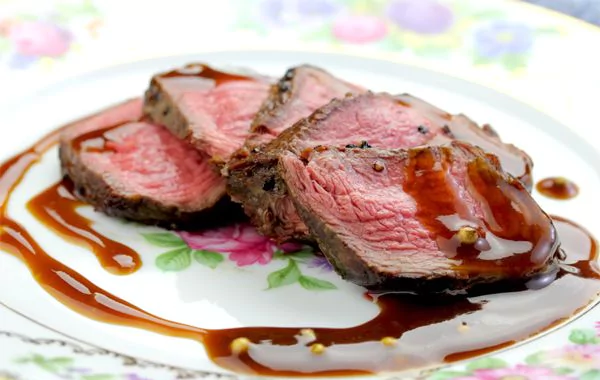This type of preparation is my favorite way to go when I buy an amazing quality cut of beef, such as filet mignon. I simply seasoned both sides of the filet mignon with salt and pepper, pan-seared until a crust formed and completed the roasting in the oven.
The key to perfection was to let the meat rest for a few minutes before slicing. The last step was making a sauce au poivre (whole peppercorn sauce) and placing the slices of beef on top like a fan. This was heavenly scrumptious. You can pair the meat with your favorite potato side dish.
1. Info for Perfect Filet Mignon Steak Recipe
- Cook Time: unavailable
- Total Time: unavailable
- Servings: 6
- Calories: unavailable
2. Ingredients for Perfect Filet Mignon Steak Recipe
- 4 (6-ounce) filet mignon steaks
- 1 teaspoon black pepper, coarsely ground
- 2 tablespoons canola oil
- 1 cup beef broth
- 1 teaspoon green, white and black whole peppercorns
3. Directions:
3.1 Cooking the beef
Preheat the oven to 450°F.
Remove the meat from the refrigerator at least 20 minutes before cooking so the beef is at room temperature.
Place the probe of a digital oven-proof thermometer in the center of one of the steaks. Set the thermometer at 125°F (see tips), depending on how pink you like the meat. (Note: The IKEA brand thermometer has a magnet so I can stick it to the hood of my stove while searing the meat.)
With a brush, grease a roasting pan with oil and heat until it’s really hot, almost to the smoking point. Pat dry the steaks. Season with salt and pepper on one side. Using tongs, place the meat (seasoned side down) in the pan (still on high heat) and cook for 3 minutes. It’s important that you not pierce the meat once it’s seared, so it stays moist and tender. Season the top with salt and pepper. Flip the meat on the other side. Pan-sear for another 2 minutes. Remove the roasting pan from the stove and transfer to the oven.
Roast the meat until you reach an internal temperature of 125-127°F.
Remove the pan from the oven. Cover with a piece of aluminum foil. Let the meat sit for at least 15 minutes as the meat temperature will rise by a few degrees right after it’s transferred from the oven. Transfer to a cutting board. Sprinkle with salt.
3.2 For the sauce au poivre
Add the Cognac to the pan. Immediately light the alcohol using an extra long lighter and allow to cook until all the flames disappear. (It’s not as scary as it seems!). Return the pan to medium heat, stir in the beef broth and add the whole peppercorns. Whisk well until well incorporated, gathering as many brown bits as possible from the bottom of the pan. Bring to a boil for 2 minutes, then let simmer for 5 minutes. Add crème fraîche and dark molasses, season with salt, then turn off the heat. Cover and let sit for 5-10 minutes until you’re ready to serve.
3.3 Assembly time
Thinly slice the steaks cross-wise (against the grain), so the meat remains tender.
Drizzle a little bit of the sauce au poivre. Fan the beef slices and baste a few pieces with the sauce. Serve immediately.
Pair with potatoes.
Bon appétit!
4. Tips and advices:
- The roasting time depends on how pink you like the meat. If you want to be absolutely sure (and this is my fool-proof way of cooking beef), just place a temperature probe in the center of the piece of meat, and remove the meat from the oven when the thermometer registers at least 125°F. You can get a digital thermometer at IKEA for a reasonable price.
- Make sure to let the beef rest (at least 15 minutes) before slicing it to ensure optimum tenderness of the meat.
- I’m a wuss when it comes to flaming alcohol. If you have long hair like me, put it in a bun! You have to act quickly and have good reflexes. Once you add the Cognac to the pan, don’t delay the lighting. You don’t want the food to absorb the raw alcohol and retain a strong brandy flavor. Another important thing is that alcohol’s boiling point is 175°F (much lower than water). The alcohol should feel warm when you’re ready to ignite it but don’t bring it to a boil.

